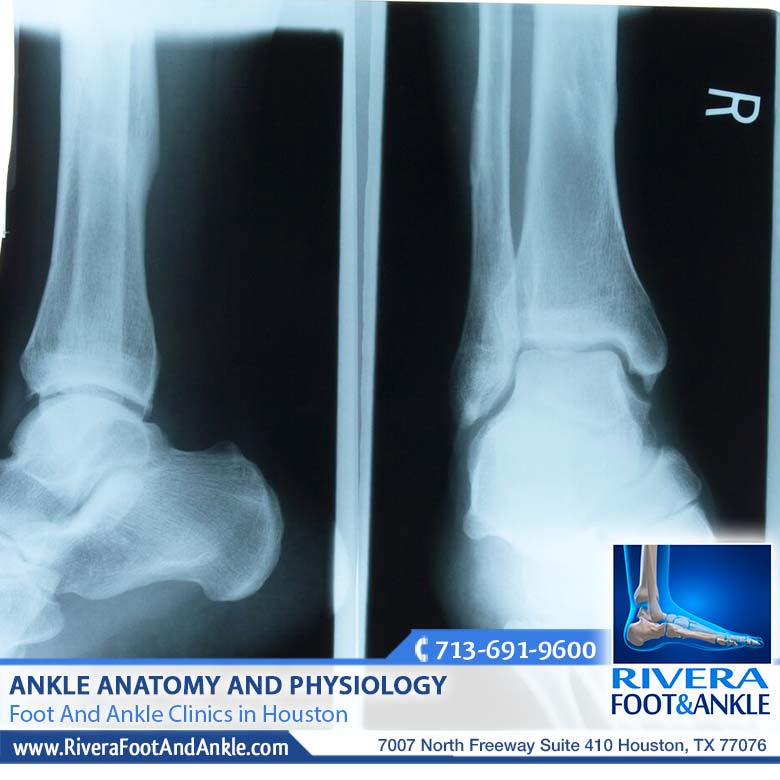Ankle Anatomy and Physiology
Foot And Ankle Clinics in Houston
The ankle and foot are incredibly complex, with a variety of connecting bones, ligaments, tendons, and muscles. The ankle is the joint where the foot attaches to the bones of the lower leg, allowing the foot to move both up and down and side to side. It is the hinge that must support your body weight and take the impact when you walk, run or jump. The ligaments, tendons, and muscles provide stability and balance. Any injuries or weakness to any of the parts of the ankle will upset your gait and ability to walk smoothly and pain-free. Bones and Joints of the Ankle Two bones of the foot (the talus and the calcaneus) connect to make the subtalar joint that allows the foot to move side to side. The tarsal bones connect to the 5 long bones of the foot - the metatarsals. The bony protrusions on the sides and back of the ankle are called malleolus. The medial malleolus is on the inside of your ankle, the lateral malleolus is on the outside of your ankle and the posterior malleolus is on the back of your ankle. Ligaments and Tendons of the Ankle It attaches the calf muscles to the heel bone to allow us to push off and up on the toes. A tear or rupture to the Achilles is bad news, with a long recovery. There are another 12 tendons that cross the ankle. They are responsible for movements of the ankle, foot, and toes; some of these tendons also help support the arches of the foot. When you sprain your ankle, you have injured one of the ligaments. The most common sprain is to the anterior talofibular ligament. The calcaneofibular ligament is also one that is injured in an ankle sprain. Muscles of the Ankle The extrinsic muscles are located outside the foot, in the lower leg. The gastrocnemius muscle (calf) is the largest. They have long tendons that cross the ankle, to attach to the bones of the foot and assist movement.
The ankle is made up of two joints: The ankle joint and the subtalar joint. The ankle joint includes two bones (the tibia and the fibula) that form a joint that allows the foot to bend up and down. This is also called the ankle joint proper or the talocrural joint. It is a synovial hinge joint.
The large Achilles tendon is the most important tendon for walking, running and jumping.
The muscles of the foot are classified as intrinsic and extrinsic. The intrinsic muscles are located within the foot and cause movement of the toes and are flexors (plantar flexors), extensors (dorsiflexors), abductors, and adductors of the toes. Several intrinsic muscles also help support the arches of the foot.
Source: verywell
RIVERA FOOT & ANKLE: At Orlando H.Rivera DPM, our priority is to deliver quality care to informed patients in a comfortable and convenient setting. When you have problems with your feet, you need to turn to a podiatrist who listens and responds… an experienced doctor who knows the field and can effectively diagnose and treat your needs… a friendly physician who counsels you on the best ways to maintain and improve your health. Our physician(s) meet all these criteria. Plus, you benefit from a dedicated team of trained professionals who give you the individualized attention you deserve.

Houston Foot and Ankle Specialist
Foot and Ankle, Dr. Orlando Rivera, Advanced Foot & Ankle Specialist, Foot and Ankle Podiatry, Houston Foot & Ankle Surgical, Treatment of Foot and Ankle, Foot & ankle specialists, Podiatrist in houston, podiatrist in houston, Orlando H.Rivera DPM, Houston Foot Doctor, Foot and Ankle Surgeon Houston, Ankle and Foot Specialist Houston, Podiatrist Houston, Foot Pain Houston.



